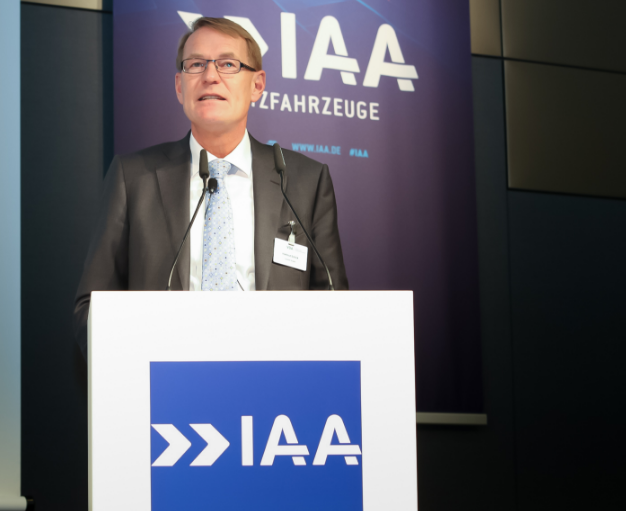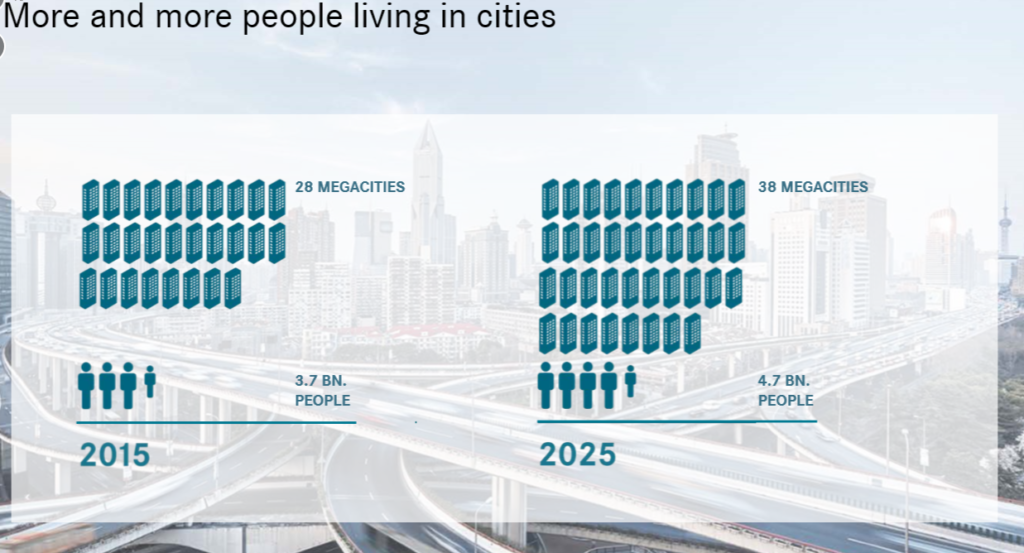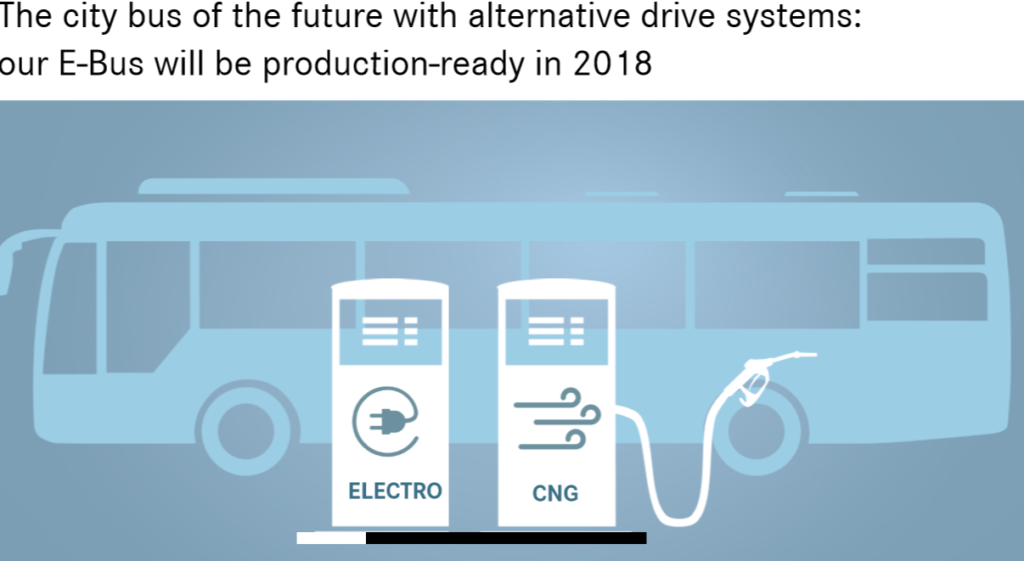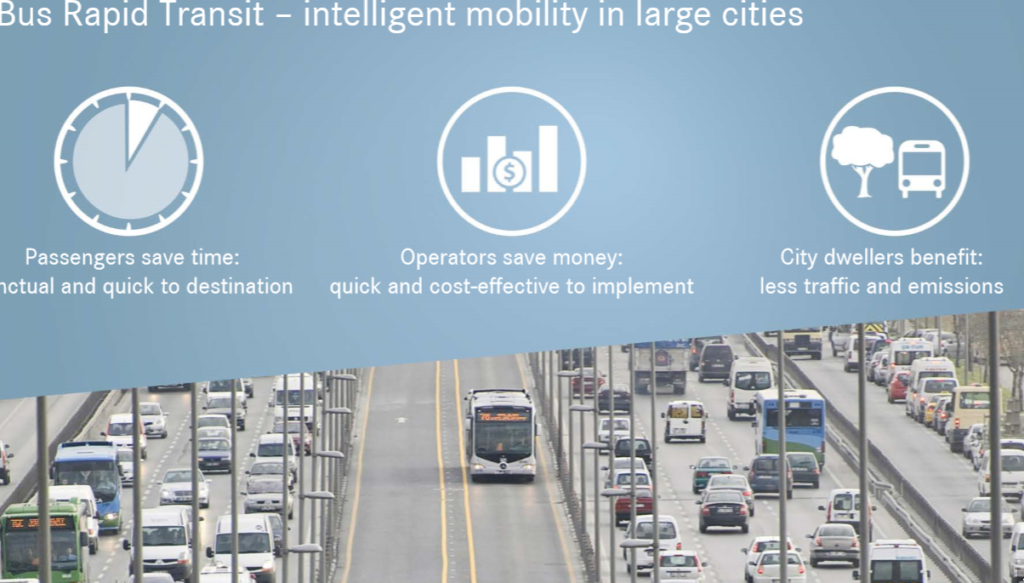Speech by Hartmut Schick, Head of the Division Daimler Buses
We’ve been hearing quite a bit about trucks. I am pleased to be spending my time talking about a few developments in the bus industry especially in the realm of city buses. It is clear that the city bus sector will see major changes in the years to come. I would like to give a few hints about what is expected at the IAA in September.
At the moment, team and fan buses are in the news almost every day. But the city bus doesn’t make headlines, perhaps because it is an established part of our everyday lives. The bus is an integral part of every modern urban centre. In fact, it is one of the most important means of public transportation. In Germany alone, buses were used over 5 billion times in 2015.
We expect similar trends to continue around the world as the global population increasingly moves to cities. In 2015, 3.7 billion people around the world were city dwellers. Forecasts suggest that by 2025, the figure will rise to some 4.7 billion. These people want to get from A to B on time, easily, and comfortably. There is no need to show pictures of commuter traffic in big cities to make my point. Today, the streets are already jam packed. As the number of people living and working in cities continue to grow, the situation is not likely to improve.
The city bus offers a practical solution here. It can take many passengers to their destinations quickly and reliably. Its systems costs for city operators are the lowest. While this is definitely very good for our industry, it doesn’t mean that the city bus is a sure thing. Indeed, it faces competition from other modes of transportation, subways and commuter trains, car sharing, taxies, cars and bicycles. A recent study that analyzed the potential of urban public transit networks showed that public transport could have been used for almost half of the routes travelled. However, public transport was used for only about 15 percent of all trips.
This means that public transit in general and buses in particular must be made more attractive to passengers in terms of punctuality, comfort, and safety. With dialog marketing, we could certainly also achieve a change of attitude with regard to user behaviour. If we do this effectively, the bus has a bright future. However, the city bus faces ever-stricter legislation with regard to the environment and noise pollution, as well as to CO2 emissions standards.
The bus also has to be attractive for our direct customers, municipal operators. This means it needs to be economical. Breakdowns have to be kept to a minimum, safety must be high and total operating costs must be low. We must master this balancing act by making the city bus of the future highly attractive for passengers, drivers, bus companies and society. To achieve this, we must develop buses that are even more eco-friendly and high-performing. This is precisely what the industry is currently working on.
Let’s have a look at the first point- how can we make the city bus of the future even more ecofriendly?
First, Euro VI is already an eco-friendly technology and our engines are very fuel efficient. We will continue to exploit the further potential of conventional drive technologies. At present, we expect about 30 percent of the city buses sold in 2030 to be equipped with diesel engines. One reason for this is that diesel will continue to be the technology of choice, especially for smaller companies.
But the drive system isn’t the only way to achieve greater efficiency. Depending on the weather and specific use, only about 50 percent of the CO2 emissions generated by city buses are the result of actual driving. The lion’s share is the result of the heating and cooling of the passenger area, or of aggregate systems. This is why we also optimize the bus’s cooling and climate systems. In addition to optimizing the overall vehicle, we also pay a great deal of attention to alternative drive systems especially to purely electric driving. At Daimler Buses, we will bring an electric bus to market by 2018 that is suitable for mass production. What makes me so sure of this?
Quite simply, battery technology is making great progress at the moment. Not only are costs decreasing dramatically, performance is also improving significantly. This is decisive in convincing our customers to use alternative drive technologies. On the one hand, electric buses must be technically feasible. On the other hand, they must also be economical for our customers. In addition, electric buses must perform just as well as conventional diesel buses.
We also want to keep spending on charging infrastructure as low as possible for our customers, as this is where a large portion of costs is generated for cities and municipalities when switching to an electric fleet. In the future, much of this infrastructure may no longer be needed when battery performance improves.
This is why comprehensive advice is needed. Together with our customers, we analyze the route that the buses will be used on. In so doing, we take the cost of infrastructure into account, as well as passenger numbers, idle times, the availability of charging stations, carbon footprint and much more. As a result, we are able to calculate how much battery capacity is needed, for instance, and where charging stations should best be located. This allows operators to determine total cost of ownership and thus assess the profitability of a bus’s use.
As a manufacturer, we do this to bring electric buses to cities. However, to make mass production feasible, we also need additional political support. This not only includes support for vehicle concepts, but also the promotion of mobility concepts for e-mobility. Just think, for instance, of solutions for telemetry services, operator concepts, and financing models. In spite of these areas of improvement, there is no doubt that the city transport of the future will be electric. We want to pave the way to this future in cooperation with our customers. This brings me to my second point, the bus industry wants to help its customers get the most out of their buses. We are further improving the performance of the city bus of the future by making it safer, more attractive to passengers and comfortable. This is the only way it can compete with other modes of public transport.
I don’t need to tell that safety is a basic requirement in our industry. We are continuously working to improve it. Our target is to prevent accidents rather than merely minimizing consequences. Passengers expect far more than safe buses. They want their buses to be on time. In this regard, we can still significantly improve the performance of modern city buses. The solution is called BRT, Bus Rapid Transit. In short, BRT comprises a special lane for buses in major cities. City buses travel separately from normal traffic. This means they are not likely to get stuck in traffic.
As a result, passengers save time and arrive at their destinations punctually. What is more, municipalities save money. Compared with subways and commuter trains, BRT can be set up much more quickly and at a lower cost. City dwellers benefit from less traffic and a smaller burden on the environment.
In major cities outside Europe, BRT has long been an established part of public transit networks. In Europe, the concept has been very successful in places like Amsterdam, Nantes and Strasburg. We at Daimler not only offer buses for BRT lines, we also offer cities advice on designing such transport systems.
When it comes to performance, we expect to make a quantum leap thanks to connectivity. For city buses connectivity offers our industry advantages that we cannot yet predict. But everyone will benefit. Let me give a few examples:
Bus depots can manage their fleets more efficiently. Thanks to real-time data, they know exactly where their buses are. This makes it possible to better plan use and reduce costs. At all times, operators can also access real-time data from the bus that provide information on things such as tyre pressure, fuel levels and wear. This makes it possible to prevent breakdowns and plan maintenance effectively. The service technician receives all information about the problem as well as suggested solutions even before he is at the vehicle. As a positive side effect, the quality and speed of repairs are improved. This helps prevent idle times and thus also saves money.
Bus drivers receive extra support. If the bus is connected to its infrastructure in real time, the driver receives all kinds of support, he can avoid traffic jams, maneuver into bus stops in the best way possible, or safely navigate building sites. Finally, passengers can travel even more comfortably thanks to e-ticketing systems, which enable passengers to purchase tickets online and save themselves the trouble of looking for change or standing in line. Waiting times that result from people paying the driver can also be avoided. Or imagine bus rides on demand, which allow users to communicate their desired destinations via their smart phones. Pre-determined stops and schedules are thus no longer necessary. Buses are used as required. This is also good for operators, the buses used can be adapted based on needs, for instance the number of passengers.
These examples are just the beginning. We want to make the city bus of the future much more than just a mode of transportation. It should also be a living space in which people can work, shop, gather information and relax. For this reason, we must offer city buses in which passengers feel just as comfortable as in their own living rooms and which can compete with other mobility offers. This not only means an attractive interior design. It also requires offering passengers modern infotainment systems, WiFi access, or information about special offers at a shopping center at the passenger’s destination.
So as you can see, there are already many possibilities and many more are feasible. This is why we at Daimler Buses recently established the “Mobility Solutions” department. Its team of 15 focusing exclusively on topics related to mobility. They are further developing existing business models and coming up with completely new concepts for our bus business.
Above all, our efforts aim to achieve one thing. We want to make our vehicles as attractive as possible for our customers and for passengers. This is because we know that urbanization, new drive concepts and connectivity present major opportunities for our industry. I know we the word “invent” tends to be overused but I do think it’s appropriate in this instance. With the possibilities available to us today, we can reinvent the bus. And that is precisely what we’re going to do.




